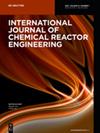Degradation of bromothymol blue and methyl green from aqueous media by Photo-Fenton: comparison between UV-lamp and sun irradiation
IF 1.2
4区 工程技术
Q4 ENGINEERING, CHEMICAL
International Journal of Chemical Reactor Engineering
Pub Date : 2024-07-12
DOI:10.1515/ijcre-2024-0057
引用次数: 0
Abstract
The degradation of two textile dye molecules was studied using photochemical processes, both in the absence and presence of light. Various methods were employed, including photolysis/UV, combined H2O2/UV photolysis, Fe2+/UV treatment, Photo-Fenton/UV at 350 nm and Photo-Fenton with solar irradiation. The decolorization efficiency of dyes in aqueous solution was evaluated for two specific dyes: Bromothymol Blue (BTB) and Methyl Green (MG). These experiments were carried out in batch mode. The results demonstrated a synergy between light irradiation and the presence of Fenton’s reagents, such as hydrogen peroxide and divalent iron. In addition, it was demonstrated that direct solar irradiation can be used without specific devices to achieve high efficiency at low cost. In the first part, we checked the impact of the various operating parameters. Reaction efficiencies were compared for the same system in the dark and under the assistance of an artificial or solar light source. In the second part, we studied the parameters of the Photo-Fenton process, such as the initial pH of the solution, the initial concentrations of oxidant, iron catalyst, and dye under irradiation from either light source. Whereas the mere photolysis without Fenton’s reagents allowed decolorization yields below 26 %, addition of the oxidant (H2O2) or the catalyst (Fe(II) species amplified the treatment efficiency. However, the presence of both H2O2 and Fe(II) under light irradiation was shown synergetic with yields ranging from 72 to 85 % depending on the dye worked and the light source: because of its broader spectrum in the UV domain, solar irradiation led to the highest decolorization yields. The above results were obtained for well-defined proportions of dye and reagents: for a 20 mg/l dye solution, Fe(II) catalyst concentration equal to 10−3 M, peroxide concentration of 5.10−2 M and a pH of 3. These conditions allowed optimal production of OH· radicals, allowing high efficiency in systems using solar irradiation.光-芬顿法降解水介质中的溴百里酚蓝和甲基绿:紫外灯和太阳照射的比较
在无光和有光的情况下,利用光化学过程对两种纺织染料分子的降解进行了研究。研究采用了多种方法,包括光解/紫外线、H2O2/紫外线联合光解、Fe2+/紫外线处理、波长为 350 纳米的光-芬顿/紫外线以及太阳能照射下的光-芬顿。对水溶液中两种特定染料的脱色效率进行了评估:溴百里酚蓝(BTB)和甲基绿(MG)。这些实验以批处理模式进行。结果表明,光照射与芬顿试剂(如过氧化氢和二价铁)的存在之间存在协同作用。此外,实验还证明,直接利用太阳光辐照可以实现低成本高效率,而无需特定装置。在第一部分,我们检查了各种操作参数的影响。我们比较了同一系统在黑暗中和在人造光源或太阳能光源帮助下的反应效率。第二部分,我们研究了光-芬顿过程的参数,如溶液的初始 pH 值,氧化剂、铁催化剂和染料在任一光源照射下的初始浓度。在不添加芬顿试剂的情况下,单纯的光解脱色率低于 26%,而添加氧化剂(H2O2)或催化剂(Fe(II) 物种)可提高处理效率。然而,在光照下同时加入 H2O2 和 Fe(II) 会产生协同效应,根据所处理的染料和光源的不同,脱色率从 72% 到 85% 不等:由于太阳光在紫外线领域的光谱更广,因此脱色率最高。上述结果是在染料和试剂比例明确的情况下获得的:对于 20 毫克/升的染料溶液,Fe(II) 催化剂浓度等于 10-3 M,过氧化物浓度为 5.10-2 M,pH 值为 3。
本文章由计算机程序翻译,如有差异,请以英文原文为准。
求助全文
约1分钟内获得全文
求助全文
来源期刊

International Journal of Chemical Reactor Engineering
ENGINEERING, CHEMICAL-
CiteScore
2.70
自引率
12.50%
发文量
107
审稿时长
6-12 weeks
期刊介绍:
The International Journal of Chemical Reactor Engineering covers the broad fields of theoretical and applied reactor engineering. The IJCRE covers topics drawn from the substantial areas of overlap between catalysis, reaction and reactor engineering. The journal is presently edited by Hugo de Lasa and Charles Xu, counting with an impressive list of Editorial Board leading specialists in chemical reactor engineering. Authors include notable international professors and R&D industry leaders.
 求助内容:
求助内容: 应助结果提醒方式:
应助结果提醒方式:


